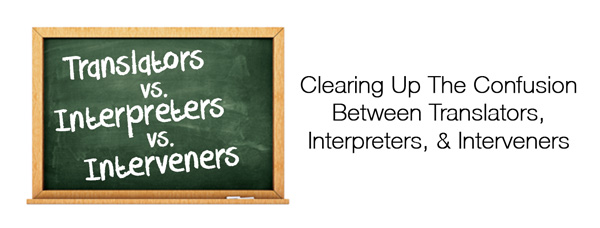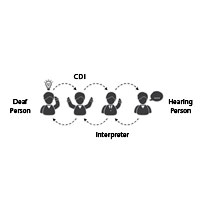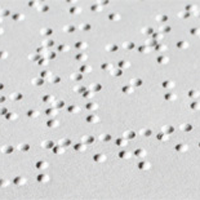
Clearing Up the Confusion Between Translators, Interpreters, and Interveners
I thought it might be interesting for the Signing Savvy community to hear a little bit about the people who work in communication fields with deaf, deafblind, and hard of hearing individuals.
It's easy to misunderstand the difference (or to even know there is a difference!) between a translator, interpreter, and intervener. However, they are different professions with varying expertise. The type of person you would work with would depend on the situation and needs of the individual, such as the level of hearing loss and if there are other communication needs to consider.
Translators
A Translator converts written materials from one language to another. It is a term that people often use interchangeably with "Interpreter." However, an Interpreter and a Translator are actually considered different professions.1 Translators work with written language and convert written materials from one language to another, while Interpreters work with spoken and sign language.
In the case of sign language, a translator would be someone (or a computer program) that translates written or typed English to Sign Language. Nearly all translation is done on a computer and requires knowledge of both Sign Language and English.
Interpreters
An Interpreter converts information from one spoken language into another— or, in the case of sign language interpreters, between spoken language and sign language. They help people who are deaf or hard of hearing and people who can hear communicate with each other.1
An Interpreter’s primary job is to act as a conduit through which communication is carried out. Although often much of their job is to listen to spoken language and turn it into signs in the air in order to communicate, they also will watch sign language and turn it into an English sentence in a spoken form.
Sign language interpreters must be fluent in English and in American Sign Language (ASL). Some interpreters specialize in oral interpretation (mouthing speech silently to aid in lip reading), cued speech (hand shapes placed near the mouth to aid in lip reading), and signing exact English.1
Interveners
An Intervener helps individuals that are deafblind communicate with others. Deafblind (yes, all one word) have both hearing and vision loss and, therefore, require different help with communication than someone with only hearing loss.
This is a job classification that is relatively new to many parts of the United States and still is a bit confusing for many people. The Intervener role, although newer to the U.S., has been around in Canada for many years. Interveners are typically a one-to-one service provider, while Interpreters often interpret one-to-one or in group settings in the front of a room.
Interveners MAY use tactile signing (making hand signs into the individual's hand) to interpret. They may also sometimes use Braille (written language used by blind and visually impaired), however, not always. In contrast, Interpreters usually would NOT be using, or be expected to know, tactile signing or Braille to communicate with deaf or hard of hearing individuals.
Related Signing Savvy Blog Articles
Sources
- Bureau of Labor Statistics, U.S. Department of Labor, Occupational Outlook Handbook, 2012-13 Edition, Interpreters and Translators. Retrieved on October 10, 2012 from http://www.bls.gov/ooh/media-and-communication/interpreters-and-translators.htm
ADVERTISEMENTS
 Interpreter 4-1-1: Certified Deaf Interpreters Explained
Interpreter 4-1-1: Certified Deaf Interpreters Explained Braille Explained
Braille Explained White House Hires Deaf ASL Interpreter
White House Hires Deaf ASL Interpreter








Sherry-LynnWednesday, November 28, 2012
As a Deafblind Intervenor, I feel I must clear up one statement in this blog... While an Intervenor MAY use tactile signing, we don't always. Deafblind individuals will have varying degrees of both hearing and visual loss, and many have enough usable vision to be able to see signing when done within a certain distance or within the indivduals range of vision.
Deafblindness is an information-gathering disability and the purpose of Intervention is to provide the information that the individual may miss due to their combined hearing/ visual losses, through a variety of mediums which may include, but are not limited to, braille, tactile signing, ASL, pics, tactile cues, etc.